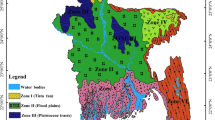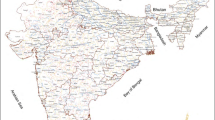Abstract
Nitrate represents one of the major pollutants of groundwater in the Gaza Strip. Several cases of blue babies disease were reported in the last couple of years. The present study is an investigation of the seasonal variations in nitrate concentration to better understand the mechanisms and parameters controlling this perilous pollutant. Nitrate was analysed in 100 wells (47 agricultural and 53 domestic) in five governorates. The results showed that 90% of the tested wells have nitrate far beyond the allowed values set by the World Health Organization (WHO). The average concentration of nitrate in domestic wells is 128 mg/L in June-July and 118 mg/L in Jan-Feb, and for the agricultural wells, the average is 100 mg/L in June-July, and 96 mg/L for Jan-Feb. The results suggest that the seasonal differences in nitrate concentrations of the domestic wells are slightly more observable than those of the agricultural wells. The environmental factors that control nitrate in groundwater are: a partially-confined aquifer, lack of a sewage system, population density, the presence of refugee camps, the presence of fertilizers and the annual rain. The variations in nitrate concentration of the domestic wells are not of considerable values. It is suggested that concrete policies in pollution control and/or prevention measures could be formulated upon better understanding of the environmental factors.




Similar content being viewed by others
References
Abu Nasr A (2003) Relationship between nitrate contamination of groundwater and methemoglobin level among infants in Jabalia, Gaza and Khanyounis, unpublished MSc thesis, Al-Quds University, Palestine, 115 pp
Al-Agha MR (1999) Impact of waste water management on groundwater quality in the Gaza Strip, Palestine. In: Chilton J (ed) Groundwater in Urban Environment. Balkemia, Rotterdam, Netherlands, pp 77–84
Al-Agha MR (1995) Environmental groundwater contamination in the Gaza Strip. Env Geol 25:109–113
Comley HH (1945) Cyanosis in infants caused by nitrates in well water. J Am Med Association 129:112–129
El-Nakhal H (1968) Geology of groundwater in Gaza Sector. MSc Thesis, Ain Shams Univ, Cairo, Egypt, 112 pp
Evans D, Moxon IR, Thomas JHC (1993) Groundwater nitrate contamination from the Old Chalford Nitrate Sensitive Area, West Oxfordshire. J Institution of Water and Environment Management 7:507–512
Kanfi, Ronen D, Magaritz M (1983) Nitrate trends in the coastal plain aquifer of Israel. J Hydrology 66:331–341
Palestinian Bureau Statistics (2000) Palestinian population in the West Bank and Gaza Strip, Jerusalem, Issue No. 2
Petakove NI, Ivanove AV (1970) Investigation of certain psychophysiological reactions in children suffering from metheamglobinaemia. Hyg Sanit 35:29–32
Uma KO (1993) Nitrates in shallow (regolith) aquifers around Sokoto Town, Nigeria. Env Geol 21:70–76
Wild A (1977) Nitrate in drinking water: Health hazard unlikely. Nature 268:197–198
World Health Organization (1996) Guidelines for drinking-water quality, 2nd edn. Health criteria and other supporting information. WHO, Geneva
Author information
Authors and Affiliations
Corresponding author
Rights and permissions
About this article
Cite this article
Maila, Y.A., El-Nahal, I. & Al-Agha, M.R. Seasonal variations and mechanisms of groundwater nitrate pollution in the Gaza Strip. Env Geol 47, 84–90 (2004). https://doi.org/10.1007/s00254-004-1136-7
Received:
Accepted:
Published:
Issue Date:
DOI: https://doi.org/10.1007/s00254-004-1136-7




